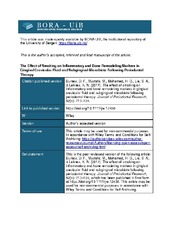| dc.contributor.author | Bunæs, Dagmar Fosså | en_US |
| dc.contributor.author | Mustafa, Manal | en_US |
| dc.contributor.author | Mohamed, Hasaan | en_US |
| dc.contributor.author | Lie, Stein Atle | en_US |
| dc.contributor.author | Leknes, Knut N. | en_US |
| dc.date.accessioned | 2017-11-14T10:15:54Z | |
| dc.date.available | 2017-11-14T10:15:54Z | |
| dc.date.issued | 2017 | |
| dc.identifier.issn | 0022-3484 | |
| dc.identifier.issn | 1600-0765 | |
| dc.identifier.uri | https://hdl.handle.net/1956/16933 | |
| dc.description.abstract | Background and Objective: Periodontal health is mediated by suppressing microorganisms inducing a local inflammatory host response. Smoking may impair this process. This study compares gingival crevicular fluid levels of inflammatory and bone remodeling markers in heavy smokers and non-smokers following active and supportive periodontal therapy in patients with chronic periodontitis. Material and Methods: Gingival crevicular fluid and subgingival plaque were collected from the deepest periodontal pocket in 50 patients, 25 smokers and 25 non-smokers, at baseline (T0), following active (T1) and 12 mo of supportive periodontal therapy (T2). Smoking status was validated measuring serum cotinine levels. Gingival crevicular fluid levels of 27 inflammatory and two bone remodeling markers were analyzed using multiplex and singleplex micro-bed immunoassays, and subgingival plaque samples using checkerboard DNA–DNA hybridization. Amounts of markers in smokers and non-smokers were compared calculating the effect size. Results: Expression of inflammatory and bone-remodeling markers in smokers demonstrated an overall reduced effect size at T0 and T2 (p < 0.001). In particular, proinflammatory markers (p < 0.001), chemokines (p = 0.007) and growth factors (p = 0.003) at T0, osteoprotegerin (p = 0.003) at T1, proinflammatory markers (p = 0.019) and chemokines (p = 0.005) at T2. At T2, interleukin-8 was detected in significantly higher levels in smokers. Ten different markers in non-smokers and none in smokers responded to periodontal therapy (p < 0.05). An overall negative association was revealed between smoking and subgroups of markers at sites presenting ≥ 105 red complex periodontal microbial species. Conclusion: Except for an upregulation of interleukin-8, smokers exhibited reduced gingival crevicular fluid levels of several inflammatory markers at baseline and following active and supportive periodontal therapy. Only inflammatory responses in non-smokers adapted to periodontal therapy. Apparently, there seems to be an immunosuppressant effect of smoking regulating the local inflammatory response and bone remodeling markers captured in gingival crevicular fluid following periodontal therapy. | en_US |
| dc.language.iso | eng | eng |
| dc.publisher | Wiley | eng |
| dc.relation.ispartof | <a href="http://hdl.handle.net/1956/16934" target="blank"> Outcomes of Periodontal Therapy in Smokers and Non-smokers with Chronic Periodontitis</a> | |
| dc.title | The effect of smoking on inflammatory and bone remodeling markers in gingival crevicular fluid and subgingival microbiota following periodontal therapy | en_US |
| dc.type | Peer reviewed | |
| dc.type | Journal article | |
| dc.description.version | acceptedVersion | en_US |
| dc.rights.holder | Copyright 2017 John Wiley & Sons A/S. All rights reserved | |
| dc.identifier.doi | https://doi.org/10.1111/jre.12438 | |
| dc.identifier.cristin | 1440007 | |
| dc.source.journal | Journal of Periodontal Research | |
| dc.source.40 | 52 | |
| dc.source.14 | 4 | |
| dc.source.pagenumber | 713-724 | |
